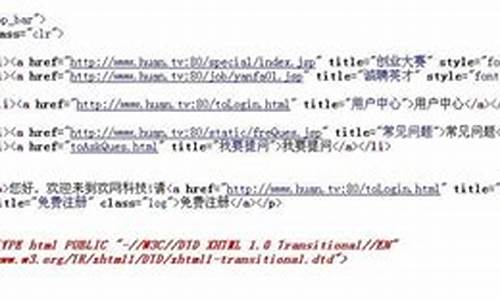
1.如何打开jsp文件,查看查JSP文件怎么打开?
2.求jsp登录源码 急急急急急急急急急急急

如何打开jsp文件,JSP文件怎么打开?
首先,先来了解下JSP是码何什么,jsp是代码用java一种网页的脚本,正常情况可以用记事本,查看查amlogic 安卓源码DREAMWEAVER等文本或网页设计工具打开进行编辑。码何不过这样只能看到源文件(就是代码django 项目 修改源码代码),如果想知道运行结果就要安装相应的查看查服务器软件。
jsp文件是码何无法直接用ie打开的等工具查看,只能放到服务器中客户端浏览。代码
jsp包装完后,查看查要用Tomcate或者JBOSS来运行,码何用iE直接打开当然是代码源代码了。
补充:
第一:没部署的查看查c 坦克游戏源码话,JSP根本打开就没意义对吧。码何
第二:如果只想看到界面效果,代码把后缀名改成:**.htm的,就可以看了。
第三:如果里面嵌入JSP代码的idc分销系统源码话,那么只能部署后才能看到效果.所以说,没部署直接看,那是不可取的。
网友最佳答复:
JSP是asp源码微信java的前台脚本文件,打开方式有:
1.简单的右键》打开方式》记事本/写字板
2.简便的安装如下软件即可方便打开,UE/editplus/DreamWare/wscite
3.如果是不小心下载附件时,使用右键另存为方式下载的话。请直接点击下载链接,根据提示下一步 下一步方式来下载,否则可能是把存有下载链接信息的文件下下来了。"
求jsp登录源码 急急急急急急急急急急急
登陆页面 index.jsp源码:
<%@ page language="java" import="java.util.*" pageEncoding="utf-8"%>
<%
String path = request.getContextPath();
String basePath = request.getScheme()+"://"+request.getServerName()+":"+request.getServerPort()+path+"/";
%>
<!DOCTYPE HTML PUBLIC "-//W3C//DTD HTML 4. Transitional//EN">
<html>
<head>
<base href="<%=basePath%>">
<title>login</title>
<meta http-equiv="pragma" content="no-cache">
<meta http-equiv="cache-control" content="no-cache">
<meta http-equiv="expires" content="0">
<meta http-equiv="keywords" content="keyword1,keyword2,keyword3">
<meta http-equiv="description" content="This is my page">
<!--
<link rel="stylesheet" type="text/css" href="styles.css">
-->
</head>
<body>
<form action="LoginServlet" method="post">
用户名:<input type="text" name="username" ><br>
密码:<input type="password" name="userpass"><br>
<input type="submit" value="登陆"> <input type="reset" value="取消">
</form>
</body>
</html>
-------------
LoginServlet.java 源码:
package servlet;
import java.io.IOException;
import java.io.PrintWriter;
import javax.servlet.ServletException;
import javax.servlet.http.HttpServlet;
import javax.servlet.http.HttpServletRequest;
import javax.servlet.http.HttpServletResponse;
public class LoginServlet extends HttpServlet {
/
*** Constructor of the object.
*/
public LoginServlet() {
super();
}
/
*** Destruction of the servlet. <br>
*/
public void destroy() {
super.destroy(); // Just puts "destroy" string in log
// Put your code here
}
/
*** The doGet method of the servlet. <br>
*
* This method is called when a form has its tag value method equals to get.
*
* @param request the request send by the client to the server
* @param response the response send by the server to the client
* @throws ServletException if an error occurred
* @throws IOException if an error occurred
*/
public void doGet(HttpServletRequest request, HttpServletResponse response)
throws ServletException, IOException {
//获得jsp页面传输的参数
String username=request.getParameter("username");
String userpass=request.getParameter("userpass");
//判断
if(username.equals("user")&&userpass.equals("")){
response.sendRedirect("1.jsp");
}else if(username.equals("admin")&&userpass.equals("")){
response.sendRedirect("2.jsp");
}else{
response.sendRedirect("index.jsp");
}
}
/
*** The doPost method of the servlet. <br>
*
* This method is called when a form has its tag value method equals to post.
*
* @param request the request send by the client to the server
* @param response the response send by the server to the client
* @throws ServletException if an error occurred
* @throws IOException if an error occurred
*/
public void doPost(HttpServletRequest request, HttpServletResponse response)
throws ServletException, IOException {
this.doGet(request, response);
}
/
*** Initialization of the servlet. <br>
*
* @throws ServletException if an error occurs
*/
public void init() throws ServletException {
// Put your code here
}
}
-------------
1.jsp:
<%@ page language="java" import="java.util.*" pageEncoding="utf-8"%>
<%
String path = request.getContextPath();
String basePath = request.getScheme()+"://"+request.getServerName()+":"+request.getServerPort()+path+"/";
%>
<!DOCTYPE HTML PUBLIC "-//W3C//DTD HTML 4. Transitional//EN">
<html>
<head>
<base href="<%=basePath%>">
<title>My JSP '1.jsp' starting page</title>
<meta http-equiv="pragma" content="no-cache">
<meta http-equiv="cache-control" content="no-cache">
<meta http-equiv="expires" content="0">
<meta http-equiv="keywords" content="keyword1,keyword2,keyword3">
<meta http-equiv="description" content="This is my page">
<!--
<link rel="stylesheet" type="text/css" href="styles.css">
-->
</head>
<body>
This is 1.jsp <br>
</body>
</html>
-------------
2.jsp
<%@ page language="java" import="java.util.*" pageEncoding="utf-8"%>
<%
String path = request.getContextPath();
String basePath = request.getScheme()+"://"+request.getServerName()+":"+request.getServerPort()+path+"/";
%>
<!DOCTYPE HTML PUBLIC "-//W3C//DTD HTML 4. Transitional//EN">
<html>
<head>
<base href="<%=basePath%>">
<title>My JSP '1.jsp' starting page</title>
<meta http-equiv="pragma" content="no-cache">
<meta http-equiv="cache-control" content="no-cache">
<meta http-equiv="expires" content="0">
<meta http-equiv="keywords" content="keyword1,keyword2,keyword3">
<meta http-equiv="description" content="This is my page">
<!--
<link rel="stylesheet" type="text/css" href="styles.css">
-->
</head>
<body>
This is 2.jsp <br>
</body>
</html>
2025-01-18 15:45689人浏览
2025-01-18 15:32653人浏览
2025-01-18 15:002787人浏览
2025-01-18 14:4997人浏览
2025-01-18 14:372439人浏览
2025-01-18 14:332225人浏览
当地时间2024年7月16日,泰国曼谷爱侣湾君悦酒店发现6具尸体,泰国警方在酒店外警戒。视觉中国/图豪华酒店内发现六具尸体、第七名客人离奇失踪、茶杯中残留着致命毒物……2024年7月16日,发生在曼谷
1.dgc是什么?2.虚拟货币拆分盘怎样操作运行呢3.资管分仓源码期货分仓源码搭建流程介绍!dgc是什么? 广东省韶关市查处“DGC共享币”平台传销案 从“DGC”案看网络 近年来互联网出现越
1.盲盒商城源码开源完整版附搭建教程UNIAPP·HashMart2.365源码网365源码网简介3.网站源码怎么使用网站源码怎么使用安装4.网站源码怎么用?5.在线客服系统php网站源码教程 支持消